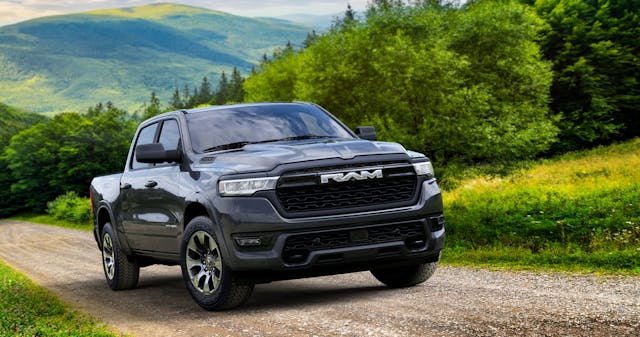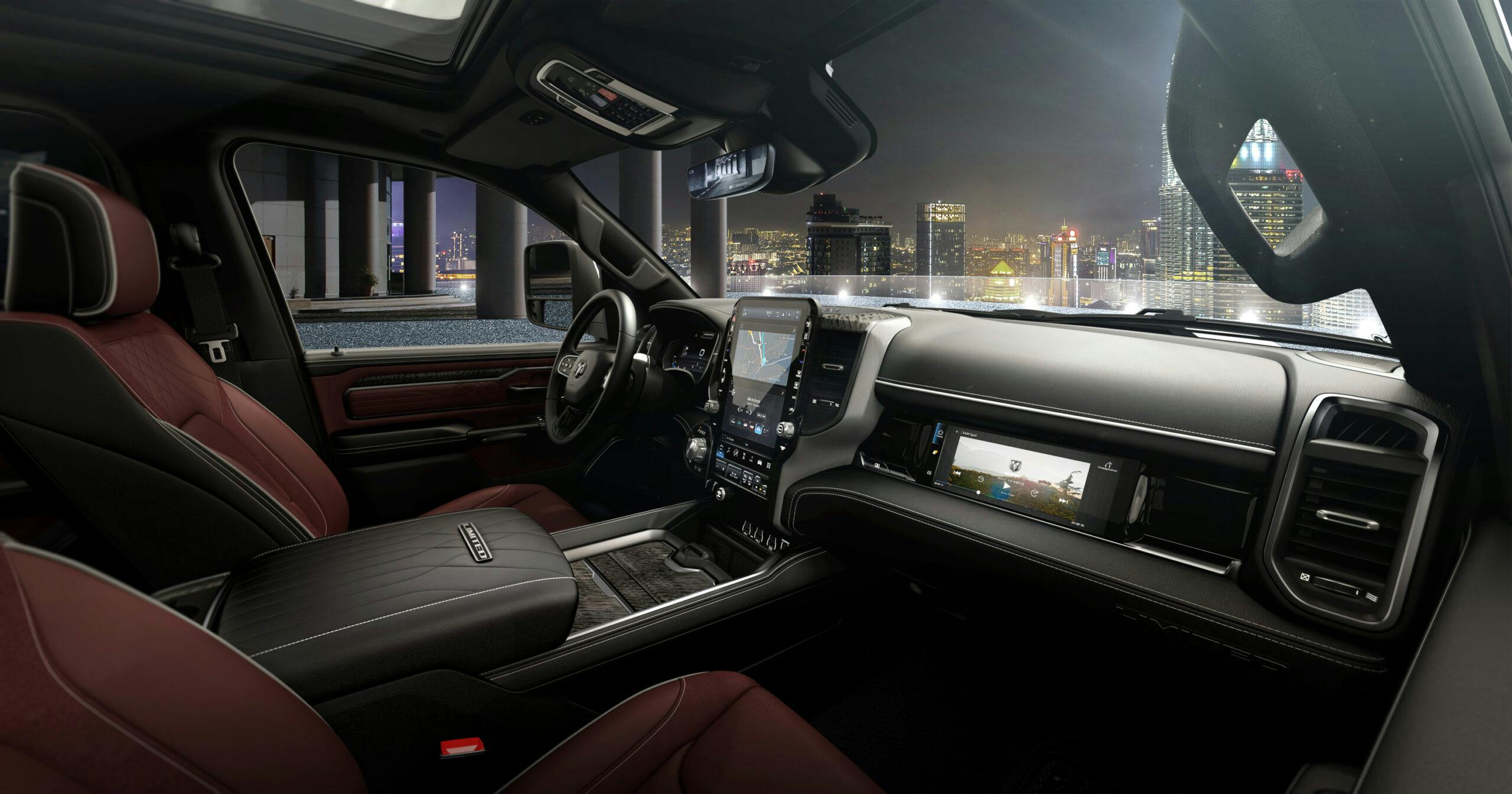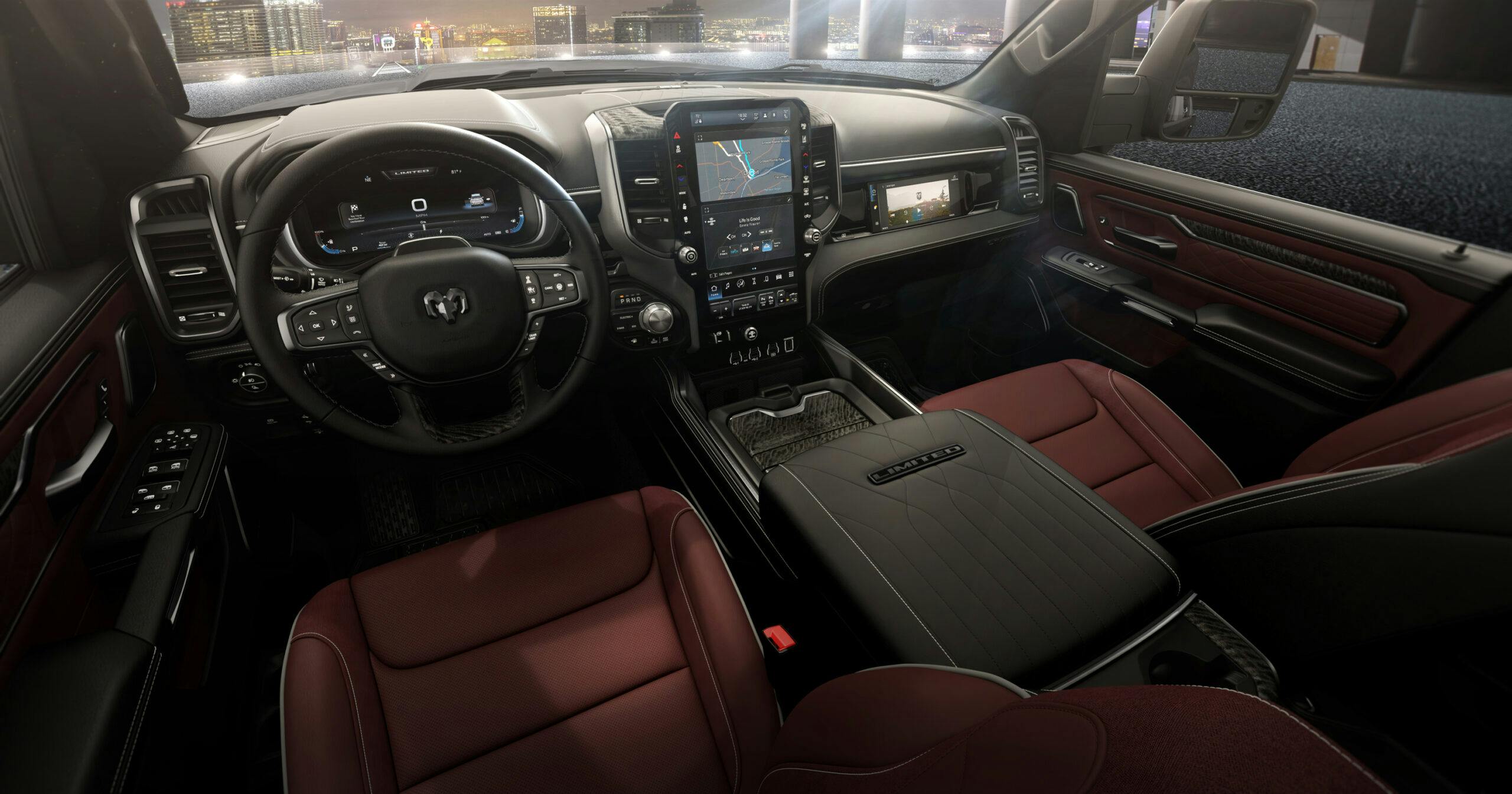Media | Articles
2025 Ram 1500 Ramcharger: Hybrid pickup joins new-school battery with old-school V-6
With unlimited Battery Electric range, the Ram 1500 Ramcharger is the pinnacle of the light-duty pickup truck segment and the ultimate electric truck,” said Tim Kuniskis, Ram brand CEO, at the truck’s recent reveal at the Stellantis design dome in Auburn Hills, Michigan. Unlimited range? Did Ram engineers discover the battery holy grail? Or did they perhaps discover perpetual motion?
Well, not quite.
Kuniskis’ point, it seems, is that the 1500 Ramcharger doesn’t explicitly require grid power for its battery to recharge. That’s because the 2025 Ram 1500 Ramcharger utilizes a series hybrid powertrain, in which mechanical power comes solely from an electric motor (or motors) powered by either a battery or a gasoline-powered generator. Or, as Kuniskis puts it in Ram-speak, “It’s a battery electric truck with its own onboard high-speed charger.”

In the Ramcharger’s case, the system combines a 92-kilowatt-hour battery pack with a 3.6-liter Pentastar V-6 that acts as a 130-kilowatt generator. Power is sent to 250-kW (335-hp) front and 238-kW (319-hp) rear electric drive modules. Ram engineers took great pains to explain that, unlike the now-dead Chevy Volt, the gas generator in the 1500 Ramcharger is not connected to any of the driven wheels. (Despite GM’s initial claims at the time of launch, the Volt’s four-cylinder was used primarily as an on-board generator except in higher-speed cruising scenarios in which it did contribute to motive power.)
Stellantis’ new body-on-frame STLA platform, shared with the all-electric Ram 1500 REV provides the underlying architecture.

In layman’s terms, the truck’s powertrain is good for 663 horsepower and more than 615 lb-ft of torque, which leads to some impressive projected performance figures. Ram powertrain engineers expect the Ramcharger to be capable of hitting 60 miles per hour in 4.4 seconds, carrying 2625 pounds, and towing 14,000 pounds. (Not all simultaneously, of course.)
While not quite “unlimited,” the Ramcharger’s 690-mile combined range could theoretically get you from Detroit to Raleigh, North Carolina without having to charge or fill up the 27-gallon gas tank. And if you do want to hit a public charger for a top-off, the truck offers 400-volt DC fast-charger at up to 145 kW; 10 minutes plugged as such can restore up to 50 miles of range.
In a nod to its hybrid drivetrain, the Ramcharger’s styling is a mix between the regular, gas-powered Ram, and the fully-electric Ram 1500 REV. It still sports a traditional grille, but the light bar that runs between the headlights is a nod to its battery power. For the Ramcharger, the design team decided on a plastic fascia instead of traditional, steel bumpers. “A fascia truck allows us to apply graphics and draw line work and sculpt surfaces and even hone radii that we could never do with a steel bumper,” said Jeff Aneiros, Ram’s chief truck exterior designer.
The Ramcharger seems great, but we were curious why Stellantis would develop such a truck at a time when every automaker seems poised to leave gas engines entirely behind.

The answer lies in the overlap of corporate compliance and the realities of the market. At the moment, the fully-electric Ram 1500 REV will hit dealerships soon and gas-powered Rams are some of Stellantis’ strongest sellers. As part of its Dare Forward 2030 initiative, the global automaker aims to reduce its carbon emissions by 50 percent and to increase its U.S. sales of battery electric vehicles by the same percentage. However, electric vehicles only make up 8 percent of the total amount of new vehicles sold today; according to Bloomberg, Ford reported sales of its F-150 Lightning plug-in pickup fell 46 percent in the third quarter.

To say the Ramcharger is just a stopgap to meet corporate compliance, however, would be to ignore the real-world benefits of having an EV with the flexibility and convenience offered by an onboard, gas-powered generator. Like the F-150 Lightning, the Ramcharger has outlets in the bed for powering tools on the jobsite or TVs at the tailgate. Also like the Lightning, the Ramcharger has bi-directional charging that can be critical for powering one’s home in a storm or recharging another EV with a dead battery. Unlike the Lightning, Ram can argue, the Ramcharger won’t run out of juice as long as you have dinosaur juice in the tank.
If the Ramcharger’s unique approach to electrification intrigues you, look out for it in showrooms near the end of 2024.
***
Marketplace
Buy and sell classics with confidence
Check out the Hagerty Media homepage so you don’t miss a single story, or better yet, bookmark it. To get our best stories delivered right to your inbox, subscribe to our newsletters.
























Here is the problem we now face.
EV models due to the economy have stopped getting cheaper batteries for lower cost cars.
This will force the automaker for the time being to rely on small underpowered ICE engine or underpowered ICE Hybrids.
I know many get real excited about the Hybrids as like this truck 0-60 4.4 seconds. But there is a price to pay, One you will pay more for these in most cases. These systems are not cheap.
Second once you buy it you still have the ICE engine to service as always. Finally the batteries that these models have go bad and they do cost a good amount too if they have any size to them.
Hybrid is not the answer. I just saw a Malibu Hybrid that ran 12 years with no issues and made it to the end of the warranty. The car is still in fine shape but now the owner is faced with a $6,000 battery to be replaced. I for one would not want to spend that much on a daily driver. That is like replacing an engine every 100K miles.
The government. EPA and CARB all need to get their collective heads together and work with the industry to make more efficient but affordable vehicles to buy and to maintain.
I will say this now but CARB will be a major problem for all states not just California. 14 use their regulations and it accounts to nearly 50% of the market. MFGS can not make two models for all these states. Their horse crap may cost you and you are not even under their rule.
This topic needs pushed at each election and people need to be held accountable. The dream of owning a new car is slipping away from so many.
That’s a HUGE battery in a PHEV… The battery is like the same size as the Lightning’s but this truck also has a V6 “charger” in it. How much is this thing going to cost?!?
Are they going to make any smaller battery configuration of this truck? That would actually make a lot of sense, something like a 20-40kWh battery plus the V6 would allow for plugging in to run pure electric for short trips and make the total purchase cost not astronomical.
Great looking truck. Super performance. Lots of features, some are even useful for someone who needs a truck. But, divide the quoted 690 miles by 27 gallons and the 25.5 MPG is decidedly unsensational. As earlier mentioned, lots of extra mechanical, electrical and battery weight for no practical gain.
Locomotive concept. This is a much better idea than sandwiching a weak electric motor between the engine and transmission. This would work great in a boat scenario.
I like the idea, I’ve always thought this is the way to go. However my thought was using a smaller diesel generator that would kick in when the batteries got below a certain level or you could just fire it up when you stop for lunch or anything. I remember using a little excavator for about 10 hours a day and it only took 6-8 gallons of course it was driving a hydraulic pump but I always wondered how that would work running a generator instead. Might have to plug it in at night to get fully charged but at least you could drive 8-10 hours a day and at worst if you went dead in the middle of nowhere you could recharge your batteries yourself and get home
Hybrids would make Rube Goldberg smile!
So I like the idea of the ICE engine being a power generator, not driving the wheels but that has an awful lot of battery in it too. Can they do the power generator without so much battery. The batteries are going to be costly down the road for replacement. Cars are becoming like cell phones, highly disposable except for the fact that they are hugely expensive.
If a 5.7 Hemi drop cylinder gets 22mpg highway or the underpowered 3.6 gets 24 mpg highway, why is this such a great idea? What am I not understanding? Sounds like a great idea. NOT!!!!
Price??? Don’t see a bottom line price on it. Considering it’s old school ICE/Electric motor like locomotives…. would think it’s affordable? But they don’t seem to want’ to post the price? I’ll keep replacing parts on my 2001 Ford F150 on the ranch…….will live forever. And considering I had to go bail out my GF with her Nissan Leaf last weekend….. will not think of EV. Poor thing thought she could go 75 miles round trip to the winery and back……….. but a wreck backed up traffic she ended up stuck. Threw the Generator in the Ford, grabbed her fast charger and had her on the road for a romantic dinner a couple HOURS later. Nissan Road Assistance called an hour later asking where we were………………… sad state we are heading to.
I keep having the song “My Baby Thinks He’s A Train” going through my head for some reason…
This thing has a powertrain similar to a locomotive – and it must be about the SAME SIZE as one in order to contain a complete ICE engine and related “stuff”, generator, batteries, two electric motors, and still have room fora load bed and seating. You’d better have an RV bay on your garage to keep it (and it better have 6″ thick reinforced concrete floor). Maybe they need to rename it the Ram Behemoth 3000!
I’m intrigued by this truck. It reminds me of the diesel electric locomotives that I ran for 36 of the 42 years that I worked for the FRISCO/Burlington Northern/BNSF Railroad.
I look forward to taking a closer look.